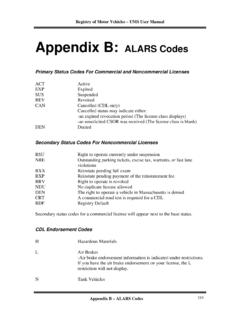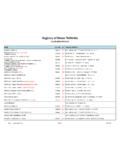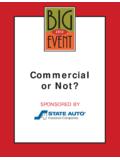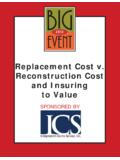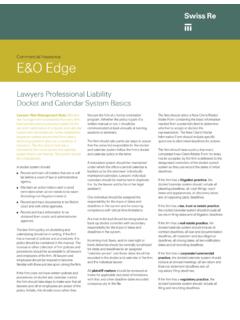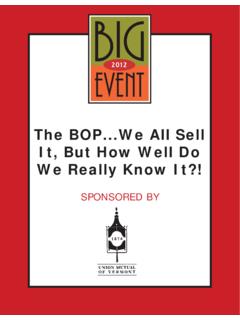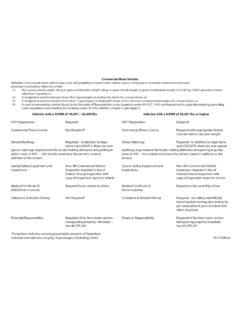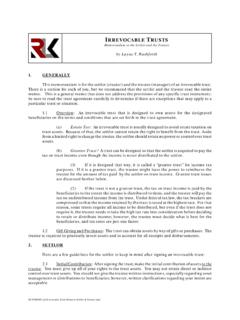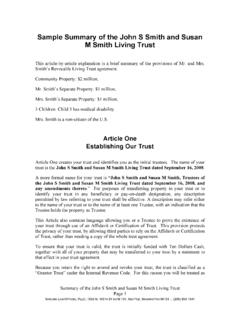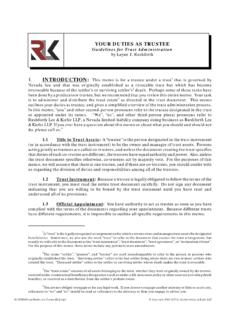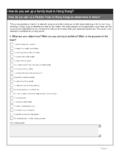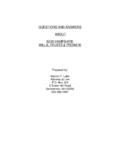Transcription of Insuring Trusts and the Personal Lines …
1 Insuring Trusts and the Personal Lines HomeownersCustomerSPONSORED BYINSURING Trusts & THE Personal Lines HO CUSTOMERR obin Federici, CPCU, AAI, ARM, AINS, AIS, CPIWPO BOX 781 NORTH KINGSTOWN, RI 02852 Phone:401-294-3557 Fax: 401-294-3557 Fred s Cell:401-524-4567 Robin s Cell: Web site: - 2 - This material has been designed for use in training programs for insurance industry personnel. It is not intended to be used as a complete reference resource on the programs and coverages outlined herein.
2 The programs use standard policy forms and endorsements for the purposes of discussing the exposures to loss that may exist, some of the coverage options available to treat them, and to provide a framework for discussions with carriers you represent concerning the programs they have available. Coverages, rules and materials presented during this program may differ from those used by individual insurance companies. Contact individual carriers for details about interpretations of their eligibility requirements, particular insurance contracts and rates.
3 Copyright 2012 by Insurance Education & Training Associates, LLC. All rights reserved. This document or any part thereof may not be reproduced or utilized in any form or by any means, electronic or mechanical, including photocopying, recording, or by any information retrieval system, without the express written consent of Insurance Education & Training Associates, LLC. Inquires should be addressed to: PO Box 781, North Kingstown, RI 02852 E-Mail: - 3 - BACKGROUND- Insurance Challenges Insurance The Basics: The homeowners policy was developed to meet the needs of individuals and families.
4 The contract provisions address coverage protection for individuals, not entities such as a trust A traditional homeowners policy does not convey any contractual benefits to any party other than a person The policy indicates that coverage applies to "you" (named insured and resident spouse) and "family members." trust vs. Insurance: The basic principle of a trust is that it separates the title of the property into two distinctive parts: 1. Legal title to the property including the right to dispose of it (the trustee s rights)2.
5 Equitable or beneficial title to the property which provides the right to use and derive benefits from the property (the residents rights usually the grantor or beneficiary) Since a trust is not a natural person, then it cannot have a spouse or family members When the trust owns the home and no adjustments are made to the basic HO policy, the coverage may inadequate - 4 - BACKGROUND- History The Historical Law of Trusts : Personal trust law developed in England at the time of the Crusades during the 12th and 13th centuries.
6 At the time, land ownership in England was based on the feudal system. When a landowner left England to fight in the Crusades, he needed someone to run his estate in his absence, often to pay and receive feudal dues. To achieve this, he would convey ownership of his lands to an acquaintance, on the understanding that the ownership would be conveyed back on his return. However, Crusaders would often return to encounter the legal owners' refusal to hand over the property. Unfortunately for the Crusader, English common law did not recognize his far as the King's courts were concerned, the land belonged to the trustee, who was under no obligation to return it.
7 The Crusader had no legal claim. The Lord Chancellor: The disgruntled Crusader would then petition the king, who would refer the matter to his Lord Chancellor. The Lord Chancellor could do what was "just" and "equitable", and had the power to decide a case according to his Lord Chancellor would consider it "unconscionable" that the legal owner could go back on his word and deny the claims of the Crusader (the "true" owner). Therefore, he would find in favor of the returning time, it became known that the Lord Chancellor's court (the Court of Chancery) would continually recognize the claim of a returning Crusader.
8 The legalowner would hold the land for the benefit of the original owner, and would be compelled to convey it back to him when Crusader was the "beneficiary" and the acquaintance the "trustee". The term use of land was coined, and in time developed into what we now know as a trust . - 5 - trust BASICS xProperty of any sort may be held in trust xGrowth assets are more commonly placed into trust (for tax and estate planning benefits)xTrust is a creature of the law in which one party the trustee manages any form ofproperty that has been transferred to the trust by the person establishing the trust the grantor or has the very highest of legal obligations.
9 A fiduciary duty to manage the property prudently and see that it is used only in a manner, and for the purposes, established by the grantor. xThepersons or institutions ( , charities) who benefit from the trust are its beneficiaries, named by the grantor in the trust document. xA Grantor's Basic Rights - The grantor may reserve the right (personally, or for others down the line ) to remove and replace the trustee for poor performance or to make other, small, administrative changes. xA trust can be viewed as a generic form of a corporationxOne of the most significant benefits of a trust is the ability to partition and shield assetsmaking it bankruptcy remote xTwo types of Trusts .
10 Trusts may be created during a person's life (living Trusts ) or after death in a will (testamentary)xAliving trust ( family trust ) can be revocable subject to termination or modification at any time by the grantor, for any reason or irrevocable (unchangeable),except for the grantors basic rightsxRevocable living trust : Assets are transferred into the ownership of the trust . Grantor retains control of those assets. The assets in the trust pass directly to the beneficiaries without going through probate upon the grantor s living trust : An irrevocable trust allows grantors to permanently and irrevocably give away assets during their lifetime.
